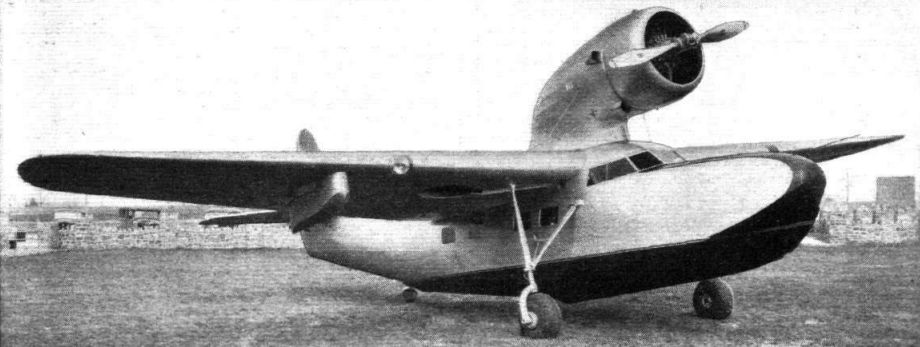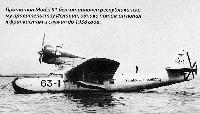
Описание
Страна : США
Год : 1935
Летающая лодка
Самолет-амфибия с экипажем из двух человек
Fairchild Model 91 и Model A-942
Компания "Pan American Airways" заказала фирме "Fairchild" летающую лодку-амфибию, пригодную для коммерческих полетов в Южной Америке и Китае (особенно в бассейнах рек Амазонка и Янцзы). В 1934 году началось проектирование амфибии Model 91. Вскоре "Pan American" сняла китайский заказ, поэтому Model 91 оптимизировали для службы на Амазонке. В итоге появилась прочная и надежная машина Model 91. Первая такая лодка впервые взлетела 5 апреля 1935 года под обозначением Model A-942-A. Это был свободнонесущий высокоплан с установленными на стойках под каждой консолью вспомогательными поплавками, двухреданным металлическим корпусом и убирающимся шасси с хвостовой опорой.
Компания "Pan American" заказала шесть амфибий Model A-942-A со звездообразными моторами Hornet мощностью 800 л.с. (597 кВт), установленными в гондолах над фюзеляжем, и тянущими винтами. Однако после поставки двух лодок авиакомпания отменила свой заказ. Из оставшихся в стадии строительства четырех планеров один достроили в виде модификации Model A-942-A.Три остальных сделали в версии Model A-942-B с моторами Wright GR-1820-F52 Cyclone мощностью 875 л. с. (652 кВт). Два самолета, приобретенные "Pan Am", прекрасно летали над Бразилией в качестве летающих лодок со снятым для увеличения полезной нагрузки колесным шасси. Из-за их большого потенциала остальные четыре машины оказались лишними. Две из них продали частным покупателям (позже одна служила в британских ВВС в Египте), еще две ушли в Японию.
ТАКТИКО-ТЕХНИЧЕСКИЕ ХАРАКТЕРИСТИКИ
Fairchild Model A-942-A
Тип: самолет-амфибия с экипажем из двух человек
Силовая установка: звездообразный поршневой мотор Pratt & Whitney R-1690-S2EG Hornet мощностью 800 л. с. (597 кВт)
Летные характеристики: макс. скорость 269 км/ч на высоте 760 м; крейсерская скорость 220 км/ч на высоте 760 м; начальная скороподъемность 256 м/мин; практический потолок 4755 м; дальность полета 1070 км
Масса: пустого самолета 2992 кг; максимальная взлетная 4763 кг
Размеры: размах крыла 17,07 м; длина 13,00 м; высота 4,47 м; площадь крыла 44,87 м2
Полезная нагрузка: до восьми пассажиров
Описание:
- Fairchild Model 91 и Model A-942
- Flight, May 1935
PAN AMERICAN'S NEW AMPHIBIAN
Фотографии
-
Flight 1935-05 / Flight
FOR SERVICE IN SOUTH AMERICA: The first of six new high-speed amphibians which are to be used along the Amazon River from Para to Manaos and in other sections of the Pan American Airways system.
-
Air Enthusiast 1972-11 / Talkback
Регистрационный номер: PP-PAP The photograph of the Fairchild 91 PP-PAP in service with Panair do Brasil. The example acquired by the RAF may in fact have been c/n 9405, purchased from Gar Wood.
-
Flight 1936-03 / Flight
PAN AMERICAN DEBUTANTE. American modernity is the keynote of this view of the first Fairchild Baby Clipper (P. & W. Hornet) moored after its delivery flight to Pan American Airways at the International Airport, Miami. This particular machine will be used between Para and Manaos down the Amazon River.
-
Air Enthusiast 1972-01 / Plane facts
The sole Fairchild 91 acquired by the Spanish Nationalist forces in March 1937 following the interception of the Spanish Republican Mar Cantabrico.
-
Мировая Авиация 124
Прототип Model 91 был отправлен республиканскому правительству Испании, однако потом он попал к франкистам и служил до 1938 года.
-
Air Pictorial 1956-08 / Photos by request
R.A.F.'s MYSTERY CLIPPER. Better known by its P.A.A. (China) name of F-91 Baby Clipper, the Fairchild XA-942A of 1934 was an all-metal eight-seat amphibian powered by either a Wright Cyclone or (in this case) an 800-h.p. P. & W . Hornet S3E-G radial. Hal G. Martin, who took this unique photo, has been able to fill in some of the missing detail of the R.A.F.'s sole XA-942A. Painted green and white, ex-NC15952 was purchased by the British American Ambulance Corps. and named "Wings of Mercy" - and was originally intended for Channel Spitfire rescues. Max. speed 215 m.p.h., cruise 167 m.p.h . ; a.u.w. 9.700 lb.; span 56 ft.; length 47 ft . P.A.A. never took delivery of the (3rd) Baby Clipper.
-
Air Enthusiast 1972-01 / Plane facts
The Fairchild 91 amphibian evaluated by the Japanese Imperial Navy as the Type А Amphibious Transport.
-
Air Enthusiast 1972-05 / Talkback
Регистрационный номер: HK832 The Fairchild 91 HK832 photographed in North Africa with the "Baby Clipper" symbol faintly visible on the nose.
-
Flight 1936-03 / Flight
Points of interest to be seen in this elevation of the Fairchild Baby Clipper include the anchors and drogues in the bow compartment, airscrew guard over the forward hatch, accommodation for passengers and crew, retracting tail wheel and the general compactness of the whole layout. The engine is a 750 h.p. nine-cylinder Hornet radial.
- Фотографии









